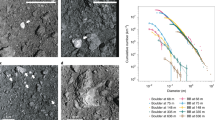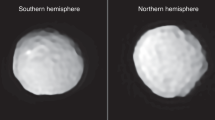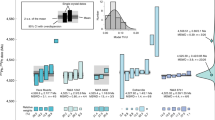Abstract
Seven of the nine known Mars Trojan asteroids belong to an orbital cluster1,2 named after its largest member, (5261) Eureka. Eureka is probably the progenitor of the whole cluster, which formed at least 1 Gyr ago3. It has been suggested3 that the thermal YORP (Yarkovsky–O'Keefe–Radzievskii–Paddack) effect spun up Eureka, resulting in fragments being ejected by the rotational-fission mechanism. Eureka’s spectrum exhibits a broad and deep absorption band around 1 μm, indicating an olivine-rich composition4. Here we show evidence that the Trojan Eureka cluster progenitor could have originated as impact debris excavated from the Martian mantle. We present new near-infrared observations of two Trojans ((311999) 2007 NS2 and (385250) 2001 DH47) and find that both exhibit an olivine-rich reflectance spectrum similar to Eureka’s. These measurements confirm that the progenitor of the cluster has an achondritic composition4. Olivine-rich reflectance spectra are rare amongst asteroids5 but are seen around the largest basins on Mars6. They are also consistent with some Martian meteorites (for example, Chassigny7) and with the material comprising much of the Martian mantle8,9. Using numerical simulations, we show that the Mars Trojans are more likely to be impact ejecta from Mars than captured olivine-rich asteroids transported from the main belt. This result directly links specific asteroids to debris from the forming planets.
This is a preview of subscription content, access via your institution
Access options
Access Nature and 54 other Nature Portfolio journals
Get Nature+, our best-value online-access subscription
$29.99 / 30 days
cancel any time
Subscribe to this journal
Receive 12 digital issues and online access to articles
$119.00 per year
only $9.92 per issue
Buy this article
- Purchase on Springer Link
- Instant access to full article PDF
Prices may be subject to local taxes which are calculated during checkout



Similar content being viewed by others
References
Christou, A. et al. New Martian Trojans and an update on the Eureka cluster. In European Planetary Science Congress Abstracts Vol. 9, id. EPSC2014-696 (European Planetary Science Congress, 2014).
de la Fuente, C. & de la Fuente, R. Three new stable L5 Mars Trojans. Mon. Not. R. Astron. Soc. 432, L31–L35 (2013).
Cuk, M. Christou, A. A. & Hamilton, D. P. Yarkovsky-driven spreading of the Eureka family of Mars Trojans. Icarus 252, 339–346 (2015).
Rivkin, A. S. et al. Composition of the L5 Mars Trojans: neighbors, not siblings. Icarus 192, 434–441 (2007).
DeMeo, F. E. & Carry, B. The taxonomic distribution of asteroids from multi-filter all-sky photometric surveys. Icarus 226, 723–741 (2013).
Ehlmann, B. L. & Edwards C. S. Mineralogy of the Martian surface. Annu. Rev. Earth Planet. Sci. 42, 291–315 (2014).
McSween, H. Y. SNC meteorites—clues to Martian petrologic evolution? Rev. Geophys. 23, 391–416 (1985).
Bertka, C. M. & Fei, Y. Mineralogy of the Martian interior up to core–mantle boundary pressures. J. Geophys. Res. 102, 5251–5264 (1997).
Zuber, M. T. The crust and mantle of Mars. Nature 412, 220–227 (2001).
Borisov, G. et al. The olivine-dominated composition of the Eureka family of Mars Trojan asteroids. Mon. Not. R. Astron. Soc. 466, 489–495 (2017).
DeMeo, F. E., Binzel, R. P., Slivan, S. M. & Bus, S. J. An extension of the Bus asteroid taxonomy into the near-infrared. Icarus 202, 160–180 (2009).
Shkuratov, Y., Starukhina, L., Hoffmann, H. & Arnold, G. A model of spectral albedo of particulate surfaces: implications for optical properties of the Moon. Icarus 137, 235–246 (1999).
Burt, B. J., DeMeo, F. E. & Binzel, R. P. Origin and mineralogy of olivine-dominated near-Earth asteroids. In American Astronomical Society Meeting Abstracts Vol. 224, abstr. 321.08 (American Astronomical Society, 2014).
Mustard, J. F. et al. Composition, morphology, and stratigraphy of Noachian crust around the Isidis basin. J. Geophys. Res. 114, E00D12 (2009).
Murray, C. D. & Dermott, S. F. Solar System Dynamics (Cambridge Univ. Press, 1999).
Scholl, H., Marzari, F. & Tricarico, P. Dynamics of Mars Trojans. Icarus 175, 397–408 (2005).
Chambers, J. E. Make more terrestrial planets. Icarus 152, 205–224 (2001).
Brasser, R. & Lehto, H. J. The role of secular resonances on trojans of the terrestrial planets. Mon. Not. R. Astron. Soc. 334, 241–247 (2002).
Walsh, K. J., Morbidelli, A., Raymond, S. N., O’Brien, D. P. & Mandell, A. M. A low mass for Mars from Jupiter's early gas-driven migration. Nature 475, 206–209 (2011).
Jacobson, S. A. & Morbidelli, A. Lunar and terrestrial planet formation in the Grand Tack scenario. Phil. Trans. R. Soc. A 372, 20130174 (2014).
Marinova, M. M., Aharonson, O. & Asphaug, E. Mega-impact formation of the Mars hemispheric dichotomy. Nature 453, 1216–1219 (2008).
Leinhardt, Z. M. & Stewart, S. T. Collisions between gravity-dominated bodies. I. Outcome regimes and scaling laws. Astrophys. J. 745, 79 (2012).
Nugent, C. R. et al. NEOWISE reactivation mission year one: preliminary asteroid diameters and albedos. Astrophys. J. 814, 117 (2015).
McEachern, F. M., Cuk, M. & Stewart, S. T. Dynamical evolution of the Hungaria asteroids. Icarus 210, 644–654 (2010).
Cuk, M. Chronology and sources of lunar impact bombardment. Icarus 218, 69–79 (2012)
Bottke, W. F. et al. An Archaean heavy bombardment from a destabilized extension of the asteroid belt. Nature 485, 78–81 (2012)
Bottke, W. F. et al. Dating the Moon-forming impact event with asteroidal meteorites. Science 348, 321–323 (2015).
Nyquist, L. E. et al. Ages and geologic histories of Martian meteorites. Space Sci. Rev. 96, 105–164 (2001).
Jacobson, S. A. et al. There’s too much mantle material in the asteroid belt. In 47th Lunar and Planetary Science Conference 1895 (Lunar and Planetary Institute, 2016).
Polishook, D. et al. Observations of “fresh” and weathered surfaces on asteroid pairs and their implications on the rotational-fission mechanism. Icarus 233, 9–26 (2014).
Wisdom, J. & Holman, M. Symplectic maps for the n-body problem. Astron. J. 102, 1528–1538 (1991).
Levison, H. F. & Duncan, M. J. Symplectically integrating close encounters with the Sun. Astron. J. 120, 2117–2123 (2000).
Rivkin, A. S., Brown, R. H., Trilling, D. E., Bell, J. F. & Plassmann, J. H. Near-infrared spectrophotometry of Phobos and Deimos. Icarus 156, 64–75 (2002).
Citron, R. I., Genda, H. & Ida, S. Formation of Phobos and Deimos via a giant impact. Icarus 252, 334–338 (2015).
Marinova, M. M., Aharonson, O. & Asphaug, E. Geophysical consequences of planetary-scale impacts into a Mars-like planet. Icarus 211, 960–985 (2011).
Canup, R. M. & Asphaug, E. Origin of the Moon in a giant impact near the end of the Earth’s formation. Nature 412, 708–712 (2001).
Acknowledgements
We thank F. DeMeo and B. Burt for their help with spectral analysis of olivine asteroids, and J. Mustard for providing CRISM reflectance spectra of Mars. D.P. is grateful to the Ministry of Science, Technology and Space of the Israeli government for their Ramon fellowship for post-docs. S.A.J. and A.M. were supported by the European Research Council Advanced Grant ‘ACCRETE’ (contract number 290568). O.A. acknowledges support from the Helen Kimmel Center for Planetary Science, the Minerva Center for Life Under Extreme Planetary Conditions and the I-CORE Program of the Planning and Budgeting Committee of the Council for Higher Education and the Israeli Science Foundation (Center No. 1829/12). Observations for this study were performed in Hawaii. We are most fortunate to have had the opportunity to conduct observations from the Mauna Kea Observatory, and we thank the NASA Infrared Telescope Facility staff for their continuous help.
Author information
Authors and Affiliations
Contributions
D.P. and S.A.J. led the project and wrote the manuscript. D.P. ran the observations, reduction and analysis of the spectral data. S.A.J. wrote the dynamical simulations and analysed their results. All authors participated in the interpretation of the results.
Corresponding author
Ethics declarations
Competing interests
The authors declare no competing financial interests.
Supplementary information
Supplementary Information
Supplementary Table 1 and Supplementary References (PDF 176 kb)
Rights and permissions
About this article
Cite this article
Polishook, D., Jacobson, S., Morbidelli, A. et al. A Martian origin for the Mars Trojan asteroids. Nat Astron 1, 0179 (2017). https://doi.org/10.1038/s41550-017-0179
Received:
Accepted:
Published:
DOI: https://doi.org/10.1038/s41550-017-0179



